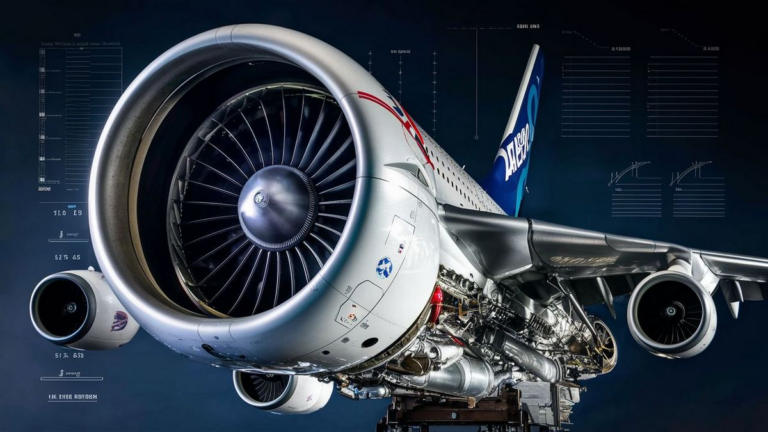When it comes to the Airbus A380, one of the most remarkable aspects that captures attention is its engine size. The Airbus A380, known for its colossal presence in the skies, boasts an impressive engine configuration that contributes to its performance, efficiency, and capability to transport passengers across continents.
Overview of Airbus A380 Engines
The Airbus A380 is equipped with four turbofan engines, each powering the aircraft with immense thrust and reliability. These engines play a pivotal role in enabling the A380 to achieve its remarkable operational capabilities, including long-haul flights and carrying a substantial number of passengers.
Engine Specifications
Each engine installed on the Airbus A380 is a Rolls-Royce Trent 900 or Engine Alliance GP7200 turbofan engine. These engines are among the most powerful and advanced in the aviation industry, designed to meet the demanding requirements of modern commercial aircraft.
The Rolls-Royce Trent 900 engine, for instance, is a high-bypass turbofan engine specifically developed for the Airbus A380. It delivers exceptional performance in terms of thrust, fuel efficiency, and environmental sustainability.
Similarly, the Engine Alliance GP7200 engine is another formidable powerplant option for the Airbus A380. Engine Alliance, a consortium of General Electric and Pratt & Whitney, designed the GP7200 to provide robust performance and reliability for long-haul operations.
Key Features
The engines installed on the Airbus A380 are characterized by their immense size and advanced technology. With a diameter of over 2.8 meters (112 inches) for each engine, they represent a significant engineering feat, reflecting the demand for power and efficiency in modern commercial aviation.
Furthermore, these engines incorporate state-of-the-art materials and engineering techniques to ensure optimal performance and durability throughout their operational lifespan. Advanced aerodynamics, efficient combustion systems, and innovative materials contribute to their impressive efficiency and reliability.
Performance and Efficiency
The Airbus A380’s engine size directly influences its performance and efficiency. With four powerful engines working in harmony, the A380 can achieve remarkable takeoff performance, climb rates, and cruising speeds while maintaining fuel efficiency and environmental sustainability.
These engines are designed to deliver the necessary thrust to propel the massive A380, allowing it to operate efficiently on long-haul routes with heavy passenger loads. The combination of advanced engine technology and aerodynamic design contributes to the A380’s reputation as one of the most efficient wide-body aircraft in service today.
In conclusion, the Airbus A380’s engine size is a testament to the relentless pursuit of innovation and excellence in commercial aviation. With its four powerful engines, the A380 represents a pinnacle of engineering achievement, enabling airlines to offer unparalleled comfort, range, and efficiency to passengers around the globe.
As technology continues to evolve, future advancements in engine design and performance may further enhance the capabilities of the Airbus A380, reaffirming its status as an iconic symbol of modern air travel.
Environmental Impact
Despite their impressive performance, the engines of the Airbus A380 also raise concerns regarding their environmental impact. The massive fuel consumption of these engines contributes significantly to carbon emissions and air pollution.
Efforts are underway within the aviation industry to develop more fuel-efficient engines and explore alternative propulsion technologies to mitigate the environmental footprint of large aircraft like the A380. Manufacturers and airlines alike are investing in research and development to improve engine efficiency and reduce emissions.
Future Trends
Looking ahead, the future of engine technology for commercial aircraft like the Airbus A380 is likely to focus on sustainability and efficiency. Emerging technologies such as electric propulsion and hybrid engines hold promise for reducing emissions and operating costs.
Moreover, advancements in materials science and manufacturing processes may lead to lighter and more durable engine components, further enhancing the performance and reliability of next-generation aircraft engines.
Frequently Asked Questions
| Question | Answer |
|---|---|
| Are the engines of the Airbus A380 fuel-efficient? | While the engines of the Airbus A380 are powerful, they consume a significant amount of fuel due to the aircraft’s size and weight. Efforts are ongoing to improve fuel efficiency and reduce emissions. |
| What is the environmental impact of the Airbus A380 engines? | The engines of the Airbus A380 contribute to carbon emissions and air pollution due to their large fuel consumption. Manufacturers and airlines are working to develop more sustainable engine technologies. |
| What are the future trends in engine technology for large aircraft? | The future of engine technology for large aircraft like the Airbus A380 is likely to focus on sustainability, efficiency, and alternative propulsion methods such as electric and hybrid engines. |
See also:






